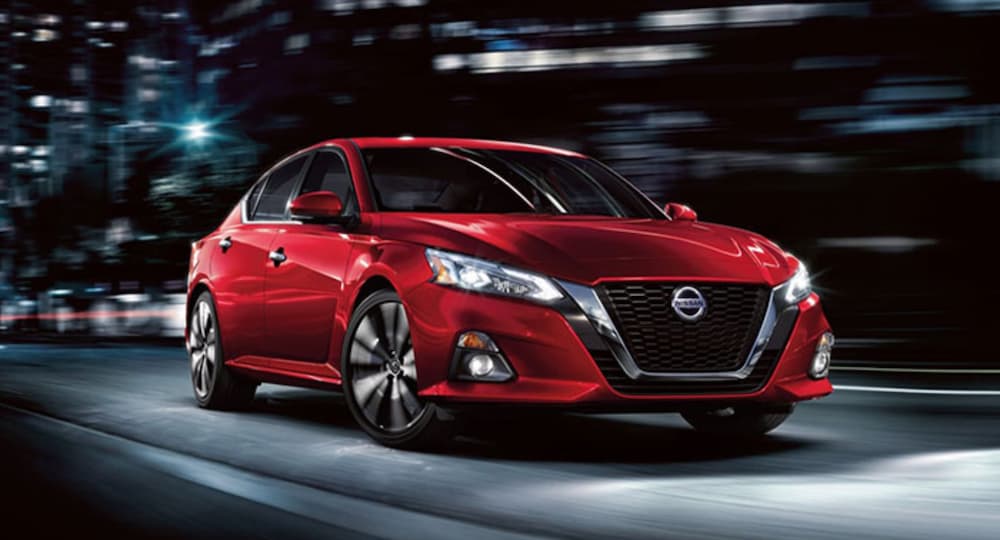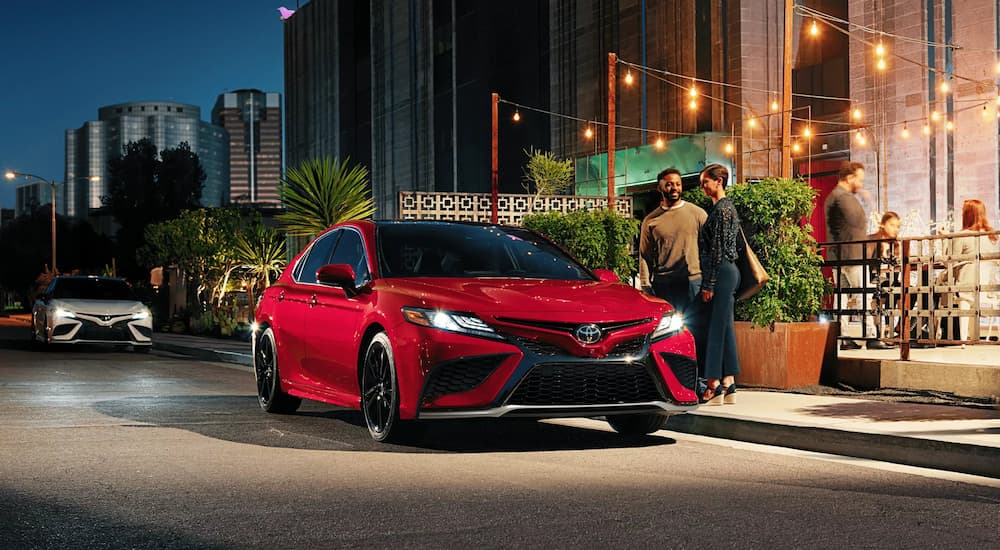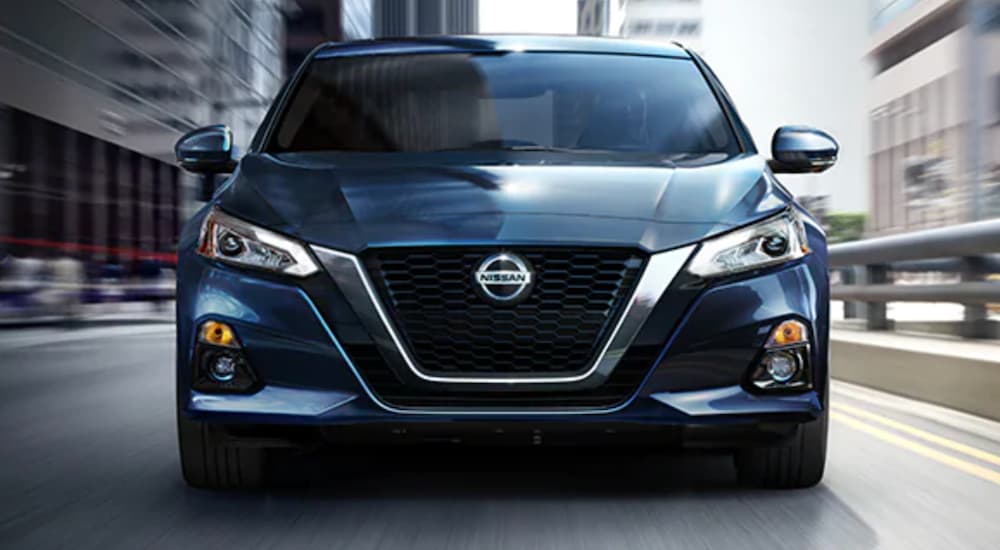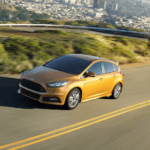In a society where bigger is always deemed better, midsize sedans easily get lost in the shuffle and are often overshadowed by larger crossovers and SUVs. However, the demand for versatile midsize sedans is still prominent, forcing automakers like Nissan to find new ways to improve sedans like the Altima and gain a lead ahead of rivals like the Toyota Camry. The best evidence of this comes from slating the 2022 Nissan Altima vs 2022 Toyota Camry.
The Altima and Camry are comparable in many ways. For example, the 2022 Altima starts at $24,900, while the 2022 Camry starts at $25,845. In addition, their expansive lineups give drivers plenty of options to find the best model for their driving, style, and comfort needs. They are also well-equipped and spacious, offering upwards of 15.4 cu.ft. of cargo space (Altima) and plenty of innovative technology via expansive touchscreen displays and advanced safety and driver-assist features. So, how do the models differ? What gives the 2022 Altima a clear advantage over the 2022 Camry? The answer to that begins with a closer look under the hood.
Defying the Odds: Power Meets Efficiency
The 2022 Altima has a distinct advantage over the 2022 Camry because of its renowned 2.0L variable compression turbocharged engine. The turbocharged powerplant churns out 248 hp and 273 lb-ft of torque, a stark contrast to the Camry’s standard 2.5L four-cylinder engine that delivers 206 hp and 186 lb-ft of torque. So, what’s the big deal about a variable compression engine?
Nissan made headlines in 2019 with the debut of the world’s first mass-produced variable compression ratio engine. In the late 1990s, Nissan began looking for ways to design an engine that delivered more power without dramatically impacting efficiency. For decades, engineers faced numerous hurdles, looking for ways to produce precision parts and methods to develop high-precision heat treatment. Finally, the team found a solution with the VC-Turbo.
Out With the Old and in With the New
In a typical gasoline engine, like what’s under the hood of the 2022 Camry, the engine compresses the mixture of fuel and air before sending it to the cylinder, where it’s ignited and combusted. The higher the compression ratio, the more efficient the engine. However, the design of the conventional engine directly connects the pistons and crankshaft to the connecting rod, resulting in a fixed compression ratio. This fixed compression limits the engine’s power delivery and performance.
Nissan improves the conventional engine design by exchanging the fixed connections of the pistons, crankshaft, and connecting rod with a multi-link system. The system rotates the crankshaft while an actuator motor varies the reach of the pistons, ultimately adjusting the compression ratio as needed. This allows the engine to optimize the compression ratio based on how much the driver engages the accelerator pedal. In other words, the compression ratio isn’t fixed and gives the engine the ability to deliver V6-like power and the efficiency of a four-cylinder.
Practical Application: The 2022 Altima
So, how does it work when you’re behind the wheel of the 2022 Altima? When you engage the accelerator pedal, the system recognizes that the compression ratio needs to change for optimal performance. As a result, the actuator motor moves the actuator arm, rotating the control shaft to move the lower-link or L-link to change the angle of the multi-link system. This movement adjusts the vertical position of the piston stroke with the cylinder, ultimately changing the compression ratio to deliver the necessary power.
This dynamic system continuously adjusts the engine’s characteristics, simultaneously maximizing performance and efficiency. Nissan lets you see as much by equipping the 2022 Altima with a meter in the sedan’s 7.0-inch Advanced Drive-Assist Display that gives you insight into this cutting-edge technology as you navigate the road ahead. You can also see it firsthand in the Altima’s exceptional fuel economy, averaging 25 MPG in the city and 34 MPG on the highway. This EPA-estimated average is a 15% increase in efficiency over the 2021 Altima and its fuel-hungry V6 engine.
NASA-Inspired Seating: Zero Gravity Seats
Beyond its exceptional ability to blend power and efficiency, the 2022 Altima has another distinct advantage over the 2022 Camry, and that’s its seating. For decades, driver fatigue has plagued the automotive industry because it directly correlates to inattentiveness and an increased risk for collisions. Advanced technology like driver alert systems have helped mitigate the issue, but Nissan has gone one step further by going to the root of the problem—seat design.
Nissan spent nearly a decade looking for ways to improve driver comfort. This research led the team to discover the weightlessness of space and its effects on astronauts. As it turns out, astronauts experienced little fatigue in space because gravity wasn’t constantly pulling on their bodies. Instead, the weightlessness put their bodies in a neutral spine posture or a natural resting position.
Nissan set out to mimic this weightlessness with its Zero Gravity seats—an integral feature of the 2022 Altima. The Altima’s Zero Gravity seats are a patented design that uses 14 unique pressure points to put your body in a neutral sitting position. This ergonomic design provides continual support across your body, from your hips to your shoulders, optimizing blood flow and improving energy levels to enhance focus.
You won’t find anything comparable in the industry. Rivals like Toyota outfit the 2022 Camry with premium seating, but it’s only premium because of its upholstery and details, not its physical design. Herringbone seat patterns and accent stitching are mere aesthetics, further proving Nissan’s commitment to your comfort. As Nissan puts it, other cars have seats while its lineup has science. For drivers, that science means a world of difference in comfort, focus, and safety.
A Virtual Spotter: Cutting-Edge Driver Tech
The 2022 Nissan Altima further distinguishes itself from competitors like the 2022 Toyota Camry with what’s known as ProPILOT Assist. Toyota outfits the Camry with its Toyota Safety Sense 2.5+ suite of driver-assist tools that includes advanced cruising technology like Full-Speed Range Dynamic Radar Cruise Control. The feature builds on traditional cruise control, using sensors and radars to monitor the flow of traffic and adjust the Camry’s cruising speed as needed to maintain a safe distance.
As with everything else we’ve seen from Nissan, advanced cruise control isn’t good enough for its lineup. Models like the 2022 Altima are equipped with ProPILOT Assist, a cutting-edge system that isn’t limited to highway speeds. Instead, it’s designed to enhance every experience behind the wheel at any speed. It can expertly navigate highway traffic by bringing the Altima to a controlled stop and then safely resuming speed when traffic moves forward. This technology gives the Altima another significant advantage over the Camry, delivering more freedom and confidence in the driver’s seat.
Exceeding Expectations Mile After Mile
Comparing the 2022 Nissan Altima vs the 2022 Toyota Camry showcases Nissan’s commitment to continuously evolving its lineup to meet the needs and exceed the expectations of drivers. We see this firsthand in the Altima’s variable compression engine that delivers the performance of a V6 engine and the efficiency of a four-cylinder engine, ultimately proving you can have the best of both worlds when you drive a Nissan. We also see it in Nissan’s exclusive Zero Gravity seats and advanced technology like ProPILOT Assist, each of which works to enhance your time on the road.
These components give the 2022 Altima a remarkable advantage in the segment and prove that you don’t have to spend more to get a well-equipped sedan that’s luxurious, affordable, and capable. While the Camry relies on Toyota’s long-standing reputation in the industry and its legacy as one of the automaker’s longest-running nameplates, Nissan continues to evolve. This evolution is giving new life to sedans like the 2022 Altima and setting the stage for a significant upset in the industry as Nissan steals the spotlight from age-old rivals like Toyota.






